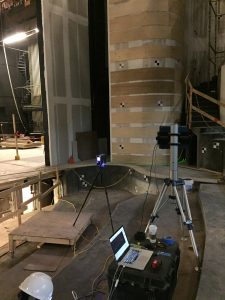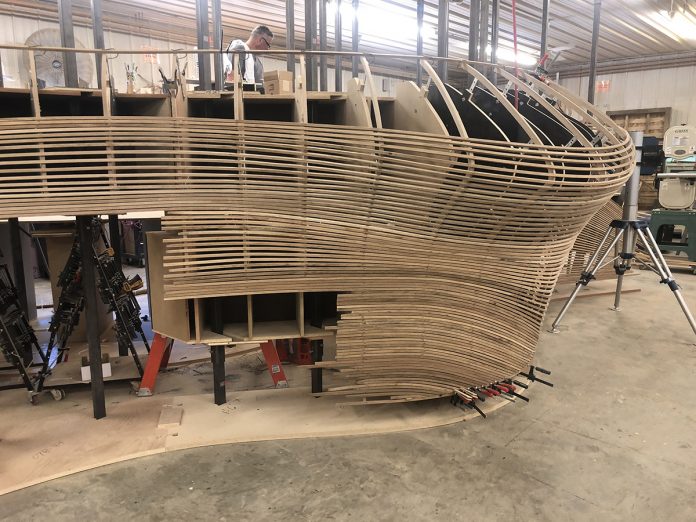FARO’s Udo Haedicke looks at the methods companies of all sizes can use to adopt prefabrication processes, what it means for people and the technology driving it
Prefabrication in the built environment industry can mean many things; at one end of the scale, much of what we use to build involves manufactured products, albeit at a small component scale. At the other end of the scale, buildings, bridges and rail tracks to name a few can be delivered to site in sections of completed modular structures.
The McKinsey report, Modular Construction: From Projects to Products (June 2019) outlines this transformation well and points to the business benefits of such a process while allaying past fears and perceptions of poorly constructed, historic prefabricated homes.
Wider publications show how assembling processes can be undertaken by robots with the often-stated claim that robots can work 24 hours a day, seven days a week, enabling companies to vastly outperform their traditional production methods.
Udo comments: “In reality, the story is slightly different; currently all automated manufacturing still requires human input or oversight. The number of people, skills and type of human interaction is different, but the requirement is still there. Additionally, robotics, although much more affordable nowadays, tend to include a significant capital cost for hardware, software and a new team to operate and maintain them.”
FARO therefore sought more flexible automated solutions and in its ever-maturing offer, now provide affordable, entry-level, yet technically advanced solutions for automation in offsite and prefabrication processes.
In the factory or workshop

Using products from their hardware and software line-up, one instance where time can be saved and accuracy increased is in the ability to take drawn or modelled fabrication data from the drafting team and assist craftsmen in marking out and positioning components to be machined or joined.
In this process from design to fabrication, upon receipt of digital design data, the combination of scanning hardware and FARO’s BuildIT software can identify the component or material on the ‘bench’ or factory floor by its own contour edges instead of additional targets. Set up of the system is therefore simple, reliable and easy to adopt in the cultural shift towards new technology in the workshop. The design data, once prepared as a projection file, can then be projected via the FARO TracerSI on to the material or object, precisely marking out where holes should be drilled, plates should be welded or material cut, for instance.
Not only can the TracerSI project on to a single surface, it has the ability to project in 3D, on multiple surfaces, allowing craftsmen to align multiple components before fixing. The Foreign Object Detection (FOD) feature points out objects that shouldn’t be present during the particular fabrication stage – this could be another component or simply fabrication waste.
Upon completion of each step, the software can check ‘what’ has been built/fabricated and the craftsmen notified if something is out of tolerance or simply in the incorrect place. This process, known as in-process verification (IPV), ensures accuracy at each stage of fabrication.
After successfully passing the verification test, craftsmen click through ‘layers’ of projection, allowing them to complete several steps of the fabrication process with ‘assistance’ from the FARO solution. Time-consuming manual measurement and marking out (and the inaccuracy that accompanies it) can in some circumstances be completely removed from the process. It’s like a real-time, augmented reality instruction manual!
Udo explains where the focus of FARO has been so far: “Key markets for this solution where proof points are available include the structural steel and precast concrete fabrication (placing of reinforcement bars and fittings etc) but this shouldn’t limit other uses – the technology can be used in many, many other situations. We’re excited to see what our amazing customers come up with!”
Onsite
Ironically in a discussion about offsite manufacturing and prefabrication, Udo explains further that the same technology solution described above can be used on site: “It’s the same solution, with a different use case.”
With concrete formwork and reinforcement bars (rebars) for instance, the solution can guide teams of workers to place the correct sized bars in the correct places based upon the latest design information.
With rebar setting out an often complex manual measurement – the FARO solution ensures confidence in the details and ultimately structural integrity of the built asset.
In a more design-focused example, Udo describes the Alliance Theatre project in Atlanta and how it demonstrates use of the FARO solution in both workshop prefabrication and onsite installation. Trahan Architects worked closely with fabrication company CW Keller & Associates to complete the renovation of the theatre including several complex double-curved timber panels.
Udo says: “The FARO solution was implemented here to assist the fabrication of the white oak panels in the workshop, projecting a precise tracer line along each of the timber ‘threads’ before fixing to the frame. The solution was used again with a different set of construction layout data onsite to ensure the correct final location of the prefabricated panels.”
In summary, the examples above highlight only a handful of cases whereby currently available technology has enabled small to medium-sized enterprises (SMEs) to enter the realm of automated working but without robots! In workshop environments, high quality, accurate mass customisation is possible. Onsite, complex designs are realised much more affordably than expected.
The FARO TracerSI fills a gap where SMEs can use technology to hugely assist manual processes though its virtual templating capabilities.
The integration of the solution into the increasingly adopted BIM process means that future uses will be more commonplace, offering benefits to various manufacturing types, built assets and ultimately the environment.
The age of the augmented worker, assisted by technology is really gathering pace…
More info at www.faro.com
Anke Abendroth
Content Manager EMEA
FARO Europe
Tel: +49 (0)7150 9797 – 311
Twitter: faroeurope
Please note: this is a commercial profile.














